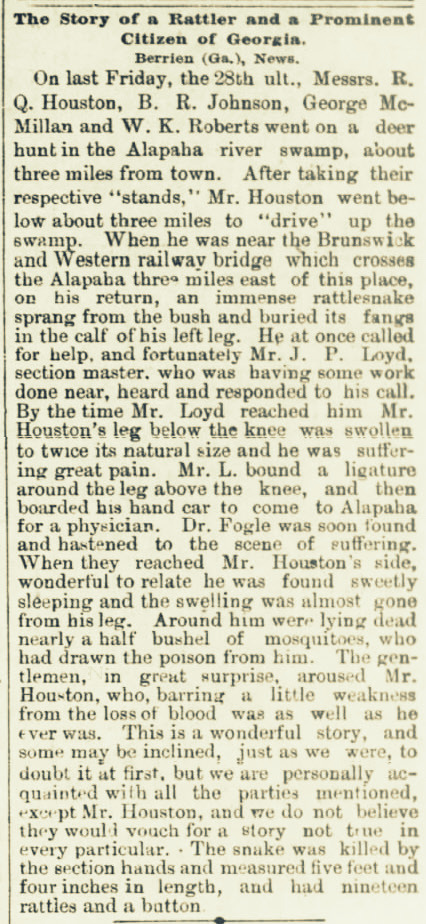In 1886, when Berrien County desperado Ben Furlong overdosed on laudanum some thought it was accidental, others thought it intentional. By the time of Furlong’s death, the dangerous potency of patent medicine narcotics was well known. In Georgia and elsewhere overdose deaths of adults were frequently reported in the newspapers as suicides.
But many victims were infants and children, fatally overdosed with mislabeled narcotic patent medicines by their well-meaning parents. “Hints to Mothers,” in 1865 observed that “three-fourths of all the deaths that take place from opium occur in children under five years of age. It has been asserted that thousands of babies died from patent medicines, products which were eventually identified by the medical community as “baby-killers.”
For centuries parents had been told teething was a particularly dangerous period of childhood development, perhaps because teething coincided with infant mortality from causes which were not at all understood. Doctors routinely reported teething on mortality schedules as a cause of infant death. The anguish of teething infants was met with anxiety by 19th century parents. Marketers of patent medicine teething elixirs preyed on the fears of parents and offered the promise of science and medicine to protect the lives of their children.
In 1880, the Berrien County mortality schedule shows the deaths of two white infants were attributed to “dentition” and “teething” by attending physician Dr. H. M. Talley. Cause of death of a black infant attended by Dr. James A. Fogle appears to have been initially recorded as “Elixir of Joseph Bain,” but that notation was crossed out and replaced with “poisoned.” Elixir of Joseph Bain, one of the first cocaine-based patent medicines, was introduced after the Civil War. Cocaine drops were frequently used in the treatment of dental pain. In Lowndes County, three children died of teething, two in Brooks County.
Among the most notorious of “baby-killer” patent medicines was “Mrs. Winslow’s Soothing Syrup” for teething infants.
From its introduction in 1849, Mrs. Winslow’s advertisements and testimonials appeared almost continuously in Georgia newspapers and elsewhere. One 1880 testimonial published in the Columbus, GA Daily Enquirer claimed “Vast quantities of the Soothing Syrup are daily sold and used here [New York]. We think Mrs. Winslow has immortalized her name by this invaluable article, and we sincerely believe thousands of children have been saved from an early grave by its timely use and that millions yet unborn will share its benefits, and unite in calling her blessed. No mother has discharged her duty to her suffering little ones, in our opinion, until she has given the benefit of Mrs. Winslow’s Soothing Syrup. Mrs. Winslow’s claimed to contain “no narcotics, nor harmful ingredients of any kind.” But, like laudanum, Mother Winslow’s was in fact opium-based.
Elixirs were made of all kinds of narcotics. Patent medicines eventually recognized as “baby-killers” included concoctions like:
- Dr. Fahrney’s Teething Sirup – Alcohol, chloroform, and morphine
- Hodnett’s Gem Soothing Sirup – opium
- Dr. Winchell’s Teething Sirup – morphine
- Children’s Comfort – morphine sulfate
- Dr. Fehy’s Pepsin Anodyne Compound – morphine sulfate
- Dr. Fowlers Strawberry and Peppermint Mixture – morphine
- Dr. Grove’s Anodyne for Infants – morphine sulfate
- Hoopers Anadyne, Infant’s Brand – morphine hydrochloride
- Jadway’s Elixer for Infants – codeine
- Dr. James Soothing Syrup – heroin
- Koepp’s Baby’s Friend – morphine sulfate
- Dr. Miller’s Anodyne for Babies – morphine sulfate and chloral hydrate
Dr. Moffet’s Teethina Teething Powders – powdered opium - Victor Infant Relief – chloroform and marijuana
Mrs. Winslow’s Soothing Syrup was available for teething and colicky babies. The company claimed that this product would greatly facilitate the process of teething, allay all pain and spasmodic action, regulate the bowels, and “give rest to mothers and relief and health to infants.” However, Mrs. Winslow’s Soothing Syrup contained morphine and alcohol, and caused coma, addiction and death in infants. – Food and Drug Administration
These were the days before the Food and Drug Administration. There were no laws regulating the sale of narcotics and medicines were not required to disclose what they contained…The children’s deaths did not go unnoticed. By the 1880s, doctors and journalists were starting to crusade against Winslow’s and its contemporaries…. In 1911, the American Medical Association added Winslow’s to its list of “baby killer” patent medicines. A 2018 Smithsonian Magazine article called the era, “America’s first opioid epidemic.” In his 1998 book, “The Excruciating History of Dentistry,” James Wynbrandt called those days, “The golden age of drug abuse.” Fueled by doctors and journalists like Adams, Congress finally passed the Pure Food and Drug Act of 1906. It required medicine labels to clearly disclose what they contained. Opiates weren’t actually regulated until the Harrison Act of 1914.- Baby-Killer Drug Invented in Maine
Related Posts:
- Death of Ben Furlong ~ Was it Suicide?
- Alapaha Star Reports 1886 Demise of Ben Furlong
- Causton’s Bluff Part 1: The Key to Savannah
- Georgia Prohibition: No Bottle in the House; No Soda at the Fount
- Sargon Once A Sign of Ray City’s Prosperity
- Ida Sloan Ray Endorsed Doan’s Pills
- George Emory Swindle Sought Cure at Buffalo Lithia Springs, VA
- The Elixir of Life























